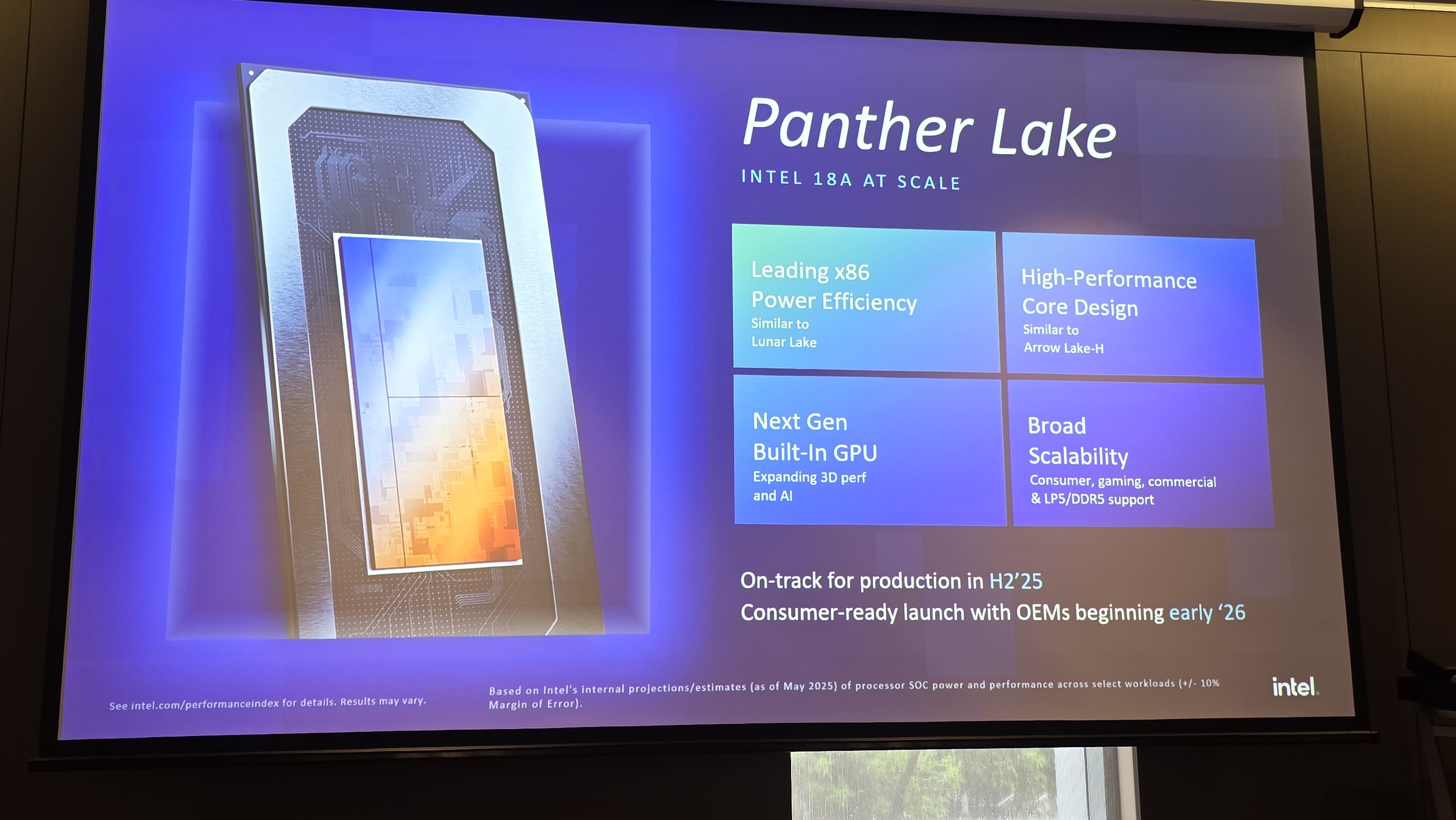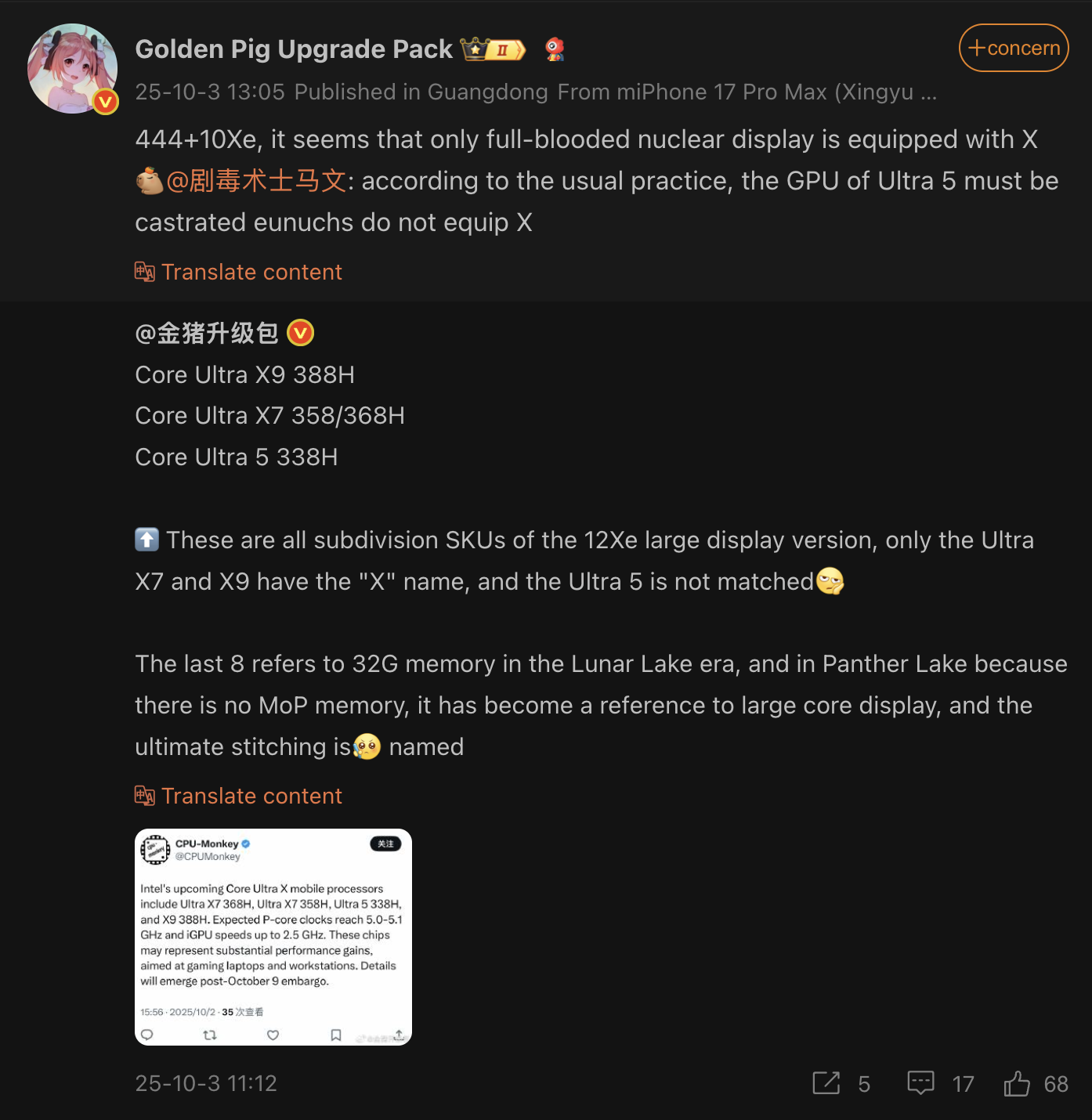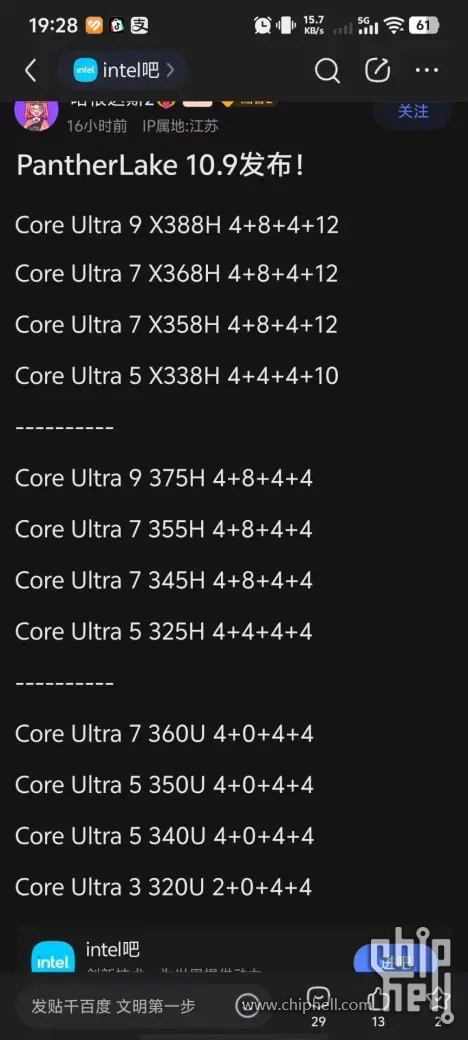Intel's upcoming Panther Lake family will reportedly feature new "Core Ultra X" branding for fully-spec'd iGPU configs — Core Ultra 7 and 9 processors tipped to feature 12 Xe3 GPU cores

According to the company, Intel is set to share details of its Panther Lake lineup of mobile processors next week. Now, leaks are starting to seep out ahead of the reportedly imminent announcements. A few weeks ago, the name "Core Ultra X" started popping up in the rumor mill with reliable tipsters reporting on a potential new branding that Intel would adopt for Panther Lake. Up until now, we didn't have any concrete info on this, but new leaks from one of the most trusted leakers in the business, the oddly-named Golden Pig Upgrade, have just filled us in on the purported details.

Intel's Xe3 graphics IP will debut on Panther Lake with every SKU featuring integrated graphics. The models with the highest-spec'd iGPUs are what will reportedly be referred to as Core Ultra X. The "X" designation allegedly represents 12 Xe3 GPU cores, a major uplift from the 8 maximum Xe2-based cores we had on Lunar Lake. But that's the thing — Panther Lake is not a Lunar Lake successor because that featured on-package memory; Panther Lake supports externally-mounted RAM. That's probably why the model numbering on Panther Lake is also shifted around.
Speaking of which, Golden Pig Upgrade lists four SKUs: three with the Core Ultra X designation and one without. Apparently, only Core Ultra X9 and X7 are getting the full-fat 12 Xe3 GPU cores, while the Core Ultra 5 midrange offering will have, at best, 10 Xe3 cores. So, overall, Core Ultra X means 12 Xe3 cores; Core Ultra 3x8 means at least 10 Xe3 cores; and Core Ultra 3x6 means less than 10 Xe3 cores. In general, Panther Lake will introduce more CPU cores across the board as well, alongside improved iGPUs, as explained below.
SKU | Core Count | GPU Cores |
|---|---|---|
Core Ultra X9 388H | 16C (4P+8E+4LP) | 12 Xe3 |
Core Ultra X7 368H | 16C (4P+8E+4LP) | 12 Xe3 |
Core Ultra X7 358H | 16C (4P+8E+4LP) | 12 Xe3 |
Core Ultra 5 338H* | 12C (4P+4E+4LP) | 10 Xe3 |
Now, all that being said, there's a slight twist in this narrative. A new leak that surfaced from Chiphell just a couple of hours later actually detailed the entire lineup, consisting of 12 SKUs that will launch this year. From that leak, it appears that there is, in fact, a Core Ultra 5 SKU as well, but it still has those 10 Xe3 Cores we mentioned earlier. This may mean that the "X" designation isn't strictly exclusive to the 12-core club, but this is a leak after all, so we'll have to wait and see. Given the discrepancy in core configs below, perhaps "X" just broadly refers to a high GPU core count.

What's more interesting, however, is how the SKUs are actually named. Instead of the Core Ultra X7 or X9, the "X" appears to precede the model number itself — Core Ultra 9 X388H, for instance. There's rumored information on a lot more models, so we'll leave you with a table (at the end) that goes over it all. It doesn't really matter how Intel names these chips; at the end of the day, we're in for a seemingly powerful upgrade regardless. Especially when it comes to integrated graphics performance, a big generational jump (Xe2-LGP to Xe3-LPG), combined with the increased core count, should give us exciting results.
Panther Lake is expected to be fabricated on the company's homegrown 18A process, and will feature an expanded LP-E island, alongside the typical P-Cores (Cougar Cove) and E-Cores (Darkmont). Intel is looking for a spiritual successor to Lunar Lake, hoping to achieve similar efficiency (battery life) but without the niche novelty tied to that generation. The fact that they're reportedly combining the naming schemes of Core Ultra 200V and Core Ultra 200H (Arrow Lake-H) could be evidence of that, and it should be enough to keep the crowd fed till the real upgrade, Nova Lake, shows up next year.
SKU | P-Cores (Cougar Cove) | E-Cores (Darkmont) | LP-E Cores (Skymont) | Xe3 GPU Cores |
|---|---|---|---|---|
Core Ultra 9 X388H | 4 | 8 | 4 | 12 |
Core Ultra 7 X368H | 4 | 8 | 4 | 12 |
Core Ultra 7 X358H | 4 | 8 | 4 | 12 |
Core Ultra 5 X338H | 4 | 4 | 4 | 10 |
Core Ultra 9 375H | 4 | 8 | 4 | 4 |
Core Ultra 7 355H | 4 | 8 | 4 | 4 |
Core Ultra 7 345H | 4 | 8 | 4 | 4 |
Core Ultra 5 325H | 4 | 4 | 4 | 4 |
Core Ultra 7 360U | 4 | 0 | 4 | 4 |
Core Ultra 5 350U | 4 | 0 | 4 | 4 |
Core Ultra 5 340U | 4 | 0 | 4 | 4 |
Core Ultra 3 320U | 2 | 0 | 4 | 4 |
Follow Tom's Hardware on Google News, or add us as a preferred source, to get our up-to-date news, analysis, and reviews in your feeds. Make sure to click the Follow button!
Get Tom's Hardware's best news and in-depth reviews, straight to your inbox.

Hassam Nasir is a die-hard hardware enthusiast with years of experience as a tech editor and writer, focusing on detailed CPU comparisons and general hardware news. When he’s not working, you’ll find him bending tubes for his ever-evolving custom water-loop gaming rig or benchmarking the latest CPUs and GPUs just for fun.
-
Notton Considering that 200V (Lunar Lake) had 8Xe2 and performed well, I'd guess 10Xe3 would perform just fine for light gaming.Reply
I would further hazard a guess that 12Xe runs into a memory bandwidth limitation, much like AMD's 370HX. Especially after Intel ditched memory on package. -
User of Computers Reply
MoP wasn't a speed boost- it was an efficiency boost.Notton said:Especially after Intel ditched memory on package. -
Notton Reply
We'll see about that...User of Computers said:MoP wasn't a speed boost- it was an efficiency boost.
Lunar Lake is LPDDR5X-8533 with MoP.
Where as the fastest RAM on an Arrow Lake laptop I could find was ... LPDDR5X-7467 on the Zephyrus G16.
Snapdragon X2 Elite is also MoP with 8448 MT/s
AMD seems to hit a wall at LPDDR5X-8000, but they use memory on PCB.
If the next gen chip doesn't hit at least LPDDR5X-8533, it'll be a regression in memory bandwidth, and you'll feel that with the iGPU. -
IBM296 Lunar Lake had impressive battery life thanks to MoP. Would be a shame if Panther Lake performed worse than that cuz Qualcomm's X2-Elite chips and Apple's M5 chips have impressive efficiency.Reply -
thestryker Reply
MTL-R and ARL only support up to 8400, but I think most OEMs are just using existing designs. I believe this is similar over on the AMD side where more are LPDDR5X-7500 despite supporting 8000. I know there are minipcs that have been updated to 8000 on the AMD side, but nothing on the major OEM side.Notton said:Where as the fastest RAM on an Arrow Lake laptop I could find was ... LPDDR5X-7467 on the Zephyrus G16.
Hopefully Crucial announcing LPDDR5X-8533 CAMM2 modules is a sign for what PTL supports out of the box. I believe that's the only mobile CPU being launched any time soon though perhaps AMD's next refresh will bump up from 8000 to 8533. -
Notton Yeah, I'm hoping for better RAM speeds too.Reply
The fastest is LPDDR5X 10.7Gbps from Samsung, which is obviously a substantial boost over 8000 or 8533. -
thesyndrome Intel's naming is still just as bad as it ever was, when I thought the entire point of removing the "i3/i5/i7" naming scheme was supposed to simplify it all (and I still remember the presentation they did where they made fun of AMD's naming, which is much simpler by comparison)Reply
Now we have the Core Ultra AND the Core Ultra X like (where the X might just be arbitrary according to the article), and the number scheme doesn't help clarify things, like we have 4 "Core Ultra 5" CPUs which are differentiated by their model number, but these also feel arbitrarily assigned: we have a 340U, a 350U, a 325H, and an X338H.... so 3 is the generation, OK, understood, but what on earth are the reasons behind numbers like 25 and 38 meant to represent?
Surely the 350U is more powerful than the 325H, right? I mean it has a bigger number! Except no, you were supposed to ignore the numbers and look at the letter suffix to indicate that the U was a low-power model and the H is a high performance model....
I actually had to go and look up the various suffixes before making this post to understand it all, and I'm someone who works with computing hardware on a daily basis, so I don't see how a regular consumer with limited knowledge is meant to pick anything out. -
User of Computers Reply
Arrow Lake used the same memory controller (and entire SoC tile as well) as Meteor Lake, which maxed out at LP5X-7467. Lunar Lake has a newer memory controller that supported higher transfer speeds. MoP does not offer any performance or latency benefits worth mentioning.Notton said:We'll see about that...
Lunar Lake is LPDDR5X-8533 with MoP.
Where as the fastest RAM on an Arrow Lake laptop I could find was ... LPDDR5X-7467 on the Zephyrus G16.
Snapdragon X2 Elite is also MoP with 8448 MT/s
AMD seems to hit a wall at LPDDR5X-8000, but they use memory on PCB.
If the next gen chip doesn't hit at least LPDDR5X-8533, it'll be a regression in memory bandwidth, and you'll feel that with the iGPU. -
thestryker Reply
While you are correct about the SoC Tile ARL and MTL refresh both support up to LPDDR5X-8400 (also DDR5-6400 vs DDR5-5600 on MTL).User of Computers said:Arrow Lake used the same memory controller (and entire SoC tile as well) as Meteor Lake, which maxed out at LP5X-7467. -
User of Computers Reply
MTL refresh? I was unaware of that particular configuration. Unless you mean ARL-U which is die-shrunk MTL (I wouldn't really call it a refresh- new and better node + major Fmax increases)thestryker said:While you are correct about the SoC Tile ARL and MTL refresh both support up to LPDDR5X-8400 (also DDR5-6400 vs DDR5-5600 on MTL).